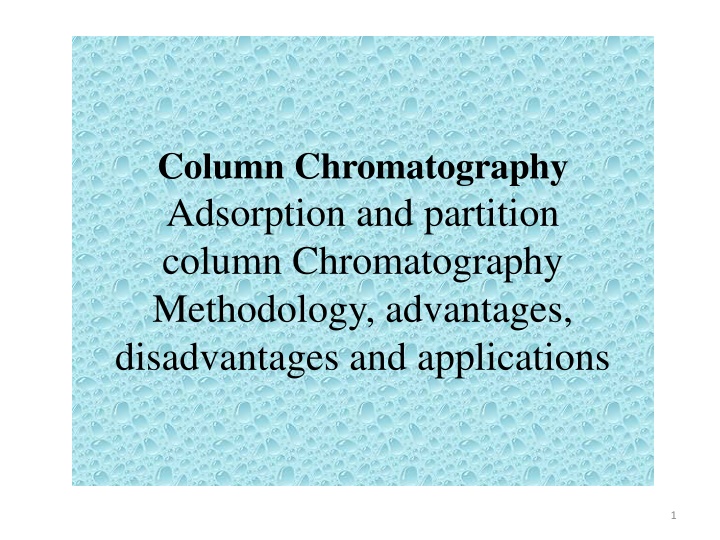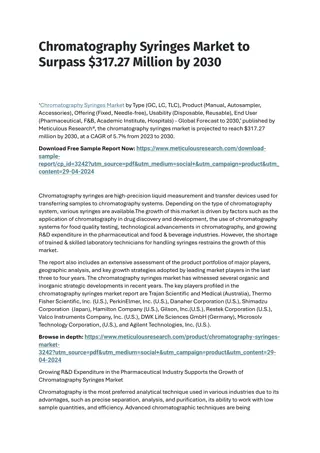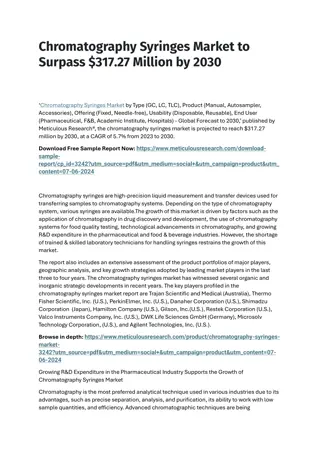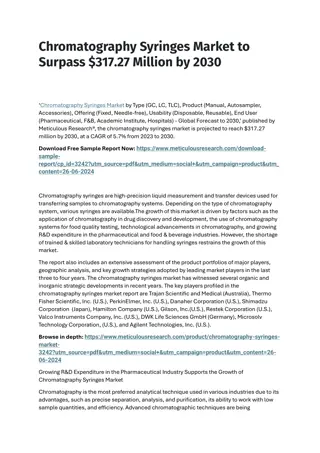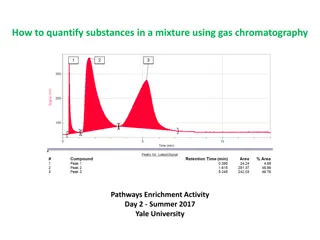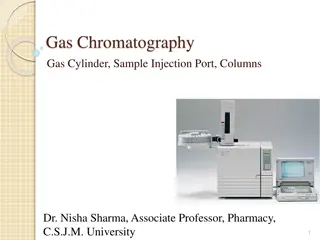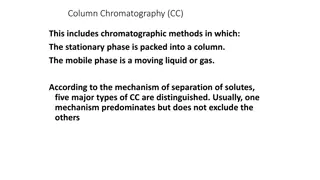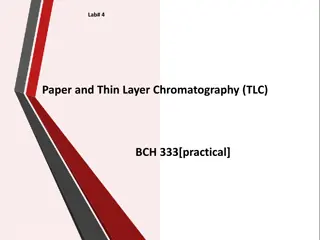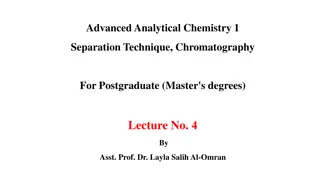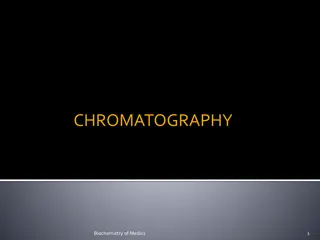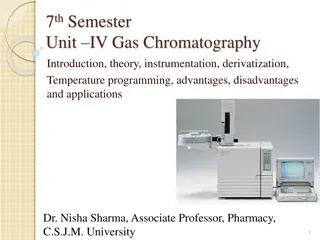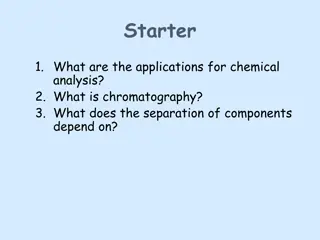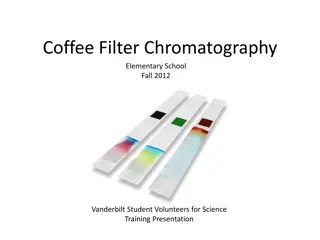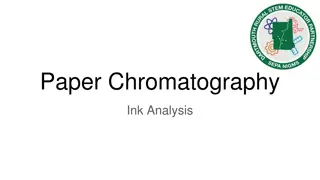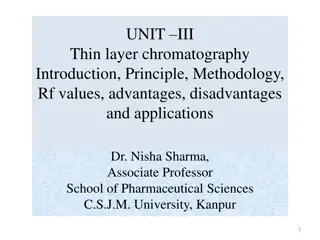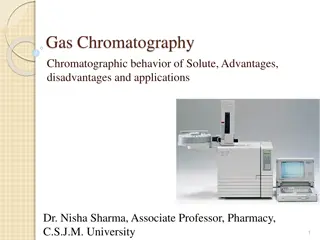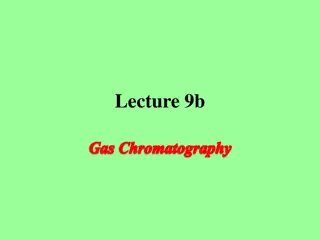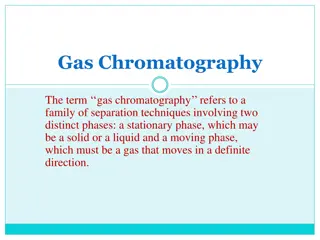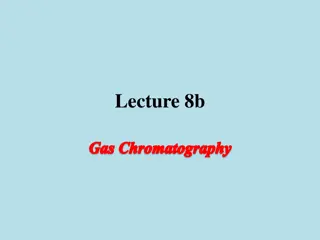Column Chromatography: Methodology, Advantages, Disadvantages, and Applications
Column chromatography, a type of adsorption chromatography, involves separating components based on their affinity to an adsorbent. The methodology includes passing a solvent through a column to improve separation, obtaining a chromatogram, and eluting components for analysis. The principle relies on intermolecular forces, such as van der Waals forces, determining binding strength. The mechanism involves molecules with varying affinity for the stationary phase. The apparatus consists of a glass tube containing adsorbent material. This technique finds applications in various fields due to its versatility.
Download Presentation

Please find below an Image/Link to download the presentation.
The content on the website is provided AS IS for your information and personal use only. It may not be sold, licensed, or shared on other websites without obtaining consent from the author.If you encounter any issues during the download, it is possible that the publisher has removed the file from their server.
You are allowed to download the files provided on this website for personal or commercial use, subject to the condition that they are used lawfully. All files are the property of their respective owners.
The content on the website is provided AS IS for your information and personal use only. It may not be sold, licensed, or shared on other websites without obtaining consent from the author.
E N D
Presentation Transcript
Column Chromatography Adsorption and partition column Chromatography Methodology, advantages, disadvantages and applications 1
Column Chromatography Introduction: It is classified under adsorption chromatography M.S. Tsvet 1906- used for separation of plant pigments Rate of adsorption varies with given adsorbent Involves principle of selective adsorption Component with adsorbing power adsorbs on upper part & with adsorbs on lower portion 2
Column Chromatography Initial separation is improved by original or suitable solvent when passed thru column Banded column or chromatogram is obtained Portion of column occupied by particular substance ZONE To separate or to estimate various constituents Column of adsorbent is pushed, various zones are cut at boundaries, extracted by elution Column washed by more solvent (eluent) collecting each component 3
Column Chromatography Principle involved 3 way equilibrium- sample, solvent, adsorbent Intermolecular forces (intermolecular, vander waal forces, ) vary in strength according to their types & cause organic molecule to bind to stationary phase Strong is the inter mol. force, stronger is the binding to stationary phase. Longer the compound takes to go through the column 4
Mechanism: 1. Consider adsorbent silica, Silica is silanol with Si OH 2. Consider molecule 1, 2 , 3 in a mixture 3. Molecules 1,2,3 bind with adsorbent as per their affinity to adsorbent (Si OH ) due to various interactive forces 4. Pass the mobile phase, the molecules 1, 2, 3 leave the surface of adsorbent as per their affinity, the one with least affinity leaves first and gets separated from mixture Molecules have Different affinity for adsorbent Si OH + fn grp in molecules molecules Passage 1 2 3 Interactive forces: Vander waal H-bonding, electrostatic int. 3 Mobile phase 2 1 Silanol: Si OH Adsorbent silica Interaction less or more 5
METHODOLOGY Apparatus 1. Straight glass tube, Ratio of 20:1 (L:D) Ex. 20-30cm L, 1-2cm D Holds 50-100g of adsorbent & several gm of adsorbate (sample) & retains several gm of adsorbate Adsorbent- supported on cotton/glass wool/perforated disc (for wide tubes) 6
APPARATUS Funnel Sand Mobile Phase Eluant Mixture to be separated Silica Fritted disk to prevent adsorbent material to pass Stop Cock Collected Eluant 7
https://www.slideshare.net/krakeshguptha/column-chromatography-26966949https://www.slideshare.net/krakeshguptha/column-chromatography-26966949 8
2. Adsorbents:Classification: According to bonding strength: Weak: Sucrose, starch, inulin, Talc, cellulose Intermediate: CaCO3. Ca3(PO4)2 Strong: Act. Silica, Charcoal, Alumina According to nature: Inorganic adsorbent: Silica gel, Alumina, Keisulguhr, Mg Silicate Organic adsorbent: Cellulose, charcoal 9
Adsorbents: Characteristics 1. Spherical particle, uniform size 2. Mechanical stability: To prevent formation of fine dust 3. Chemically inert : should not react with eluting solvents / sample 4. Inactive catalytically, neutral surface Alumina- 150mesh provides S area- 155m2/g Larger the mesh size smaller the adsorbent particle 10
Adsorbents Silica- ly porous, amorphous silicic acid in form of hard, opalescent particles, which is prepared by precipitation of waterglass with sulfuric acid alumina- activated by heating at 200 -400 C in current of air / CO2, Silica- 100 C 1h Silica gel, activated charcoal, MgO, MgCO3, CaCO3, CaSO4, , Polyacrylamide, starch, talc Weight of adsorbent 20-50 times than sample wt. 11
Preparation of column Dry packing: Cotton plug, clamp the column, Add portions of adsorbent for uniform packing Press with flat end glass rod, fill 2/3rd of tube Wet packing: suitable liq. Medium, suction pump, desired ht. should remain covered with petroleum ether always 12
Role of Solvents used: To introduce mix. To column For dev. of zone (developers) To remove req. content of each zone from mech. Separated parts (eluents) Method to introduce: Top of column- covered with cotton plug. Rate of flow of solvent maintained by suction with percolation @ 4-10cm/min. in 5cm tube 13
Solvents used: Not be dry & shrink Too much suction results into evaporation of solvent Hexane<CCl4<Toulene<DCM<CHCl3<EtO Ac<Acetone<Propanol<EtOH<MeOH<CH3 COOH<H2O 14
Analysis Two methods : 1. Adsorbent is pushed with wooden pestle/ plunger, separate the zones by dropping each zone Immediately add eluent to get suspension, filter by sintered glass funnel 15
Analysis 2. Column of adsorbent is not removed, Elution tech. (Isocratic or gradient) Chromatogram is developed with single eluent /successive solvents in ing power of eluent efficiency Different portions are washed collected in different receivers 16
PROCESS Sample loaded Mobile phase interaction Strong Stationary phase separation Sample interaction Weaker Fraction collection Eluted molecules 17
Detection If colored compd. separation- visual monitoring If colorless compds. : withdrawing small fractions in between the eluation and then testing by TLC every time 18
Factors affecting column efficiency 1. Nature of solvents: Solvent of used for efficiency separation, because rate of flow is inversely proportional to E 1/ Should be compatible with matrix used 2. Dimensions of column: By ing L/W ratio for preparative separations sample/column packing ratio 1:20, 1:100 Increasing L- improved separation 50 mm ID, 30cm L 19
Factors affecting column efficiency 3. Conduction of adsorbent: If deactivation takes place- separation 4. Temp. of column: Difficult soluble samples are generally separated at Temp. RT is best, Temp. to efficiency 5. Particle size of column packing: By ing particle size of adsorbent se separation 20
Advantages Wide choice of solvents Wide variety of mixture can be separated Small to large qty. of samples can be handled Disadvantages Time consuming Amount of solvents req. is more, so expensive 21
Applications For analytical uses: capillary 0.05-2mm (id) & 1-20m (L) Separation of geometrical isomers Isomers of carotenoids on CaCO3, Al2O3 Isomers of carboxylic acids- charcoal, silica gel Separation of tautomer mix, Keto & enol forms of p-hydroxylphenyl pyruvic acid & indolyl pyruvic acid, separated in weakly acidic med. Enol appears before ketoform in eluate 22
Applications To determine no. of components in a mix. To separate & purify substantial qty s of those components for subsequent analysis Purification of natural compounds obtained from plants Separation of end products in organic synthesis Removal of impurities 23
References Jeffry G.H., J. Mendham et al. Vogel s Text book of Quantitative Chemical Analysis, 5th Edition, 1989, Longman Scientific & Technical, Bath Press, Great Britain. G.R. Chatwal, SK Anand. Instrumental methods of chemical analysis (Analytical Chemistry), ed. 1995, Himalaya Publishing House, Bombay. A.H. Beckett & J.B. Stenlake. Practical Pharmaceutcal Chemistry, Part Two, ed. 4th, 1997, (reprint 2003) CBS Publishers & Distributors, New Delhi. 24
